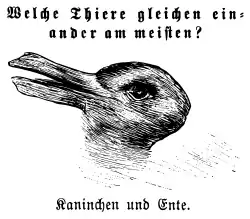Rabbit–duck illusion
The rabbit–duck illusion is an ambiguous image in which a rabbit or a duck can be seen.[1]

The earliest known version is an unattributed drawing from the 23 October 1892 issue of Fliegende Blätter, a German humour magazine. It was captioned "Welche Thiere gleichen einander am meisten?" ("Which animals are most like each other?"), with "Kaninchen und Ente" ("Rabbit and Duck") written underneath.[2]
After being used by psychologist Joseph Jastrow, the image was made famous by Ludwig Wittgenstein, who included it in his Philosophical Investigations as a means of describing two different ways of seeing: "seeing that" versus "seeing as".
Correlations
Whether one sees a rabbit or a duck, and how often, may correlate with sociological, biological and psychological factors. For example, Americans, both young and old, tend to see a bunny during Easter, and a bird/duck in October.[3] It may also indicate creativity. A standard test of creativity is to list as many novel uses as you can for an everyday object (e.g. a paper clip) in a limited time. Wiseman et al. found was that participants who easily flipped between rabbit and duck came up with an average of almost 5 novel uses for their everyday item. Those who couldn't flip between rabbit and duck at all came up with fewer than 2 novel uses.[4]
Philosophical and political implications
Several scholars suggest that the illusion resonates philosophically, and politically. Wittgenstein, as Le Penne explains, employs the rabbit-duck illusion to distinguish perception from interpretation. If you only see a rabbit, you would say "this is a rabbit," but once you become aware of the duality you would say "now I see it as a rabbit." You may also say "it's a rabbit-duck," which, for Wittgenstein, is a perceptual report. Le Penne, however, suggests that this too may be interpretation, illustrating the point through the Marxist criticism of bourgeoisie's "natural inclination for synthesis – meaning, living outside of the unsettling struggle between thesis and anti-thesis forces," seeing both the duck and the rabbit at the same time.[5]
Abulof develops the point to explain how the illusion crystallizes the interplay between freedom (choice) and facticity (forced reality). If you see just a duck, you may need to actively choose to work on seeing the rabbit too, and once you do, to then choose which you see at any given point. While submitting that "once you see the duck you cannot unsee it," Abulof claims that "trying to unsee what we already did might be less about choosing one perspective over another but about negating one, so that we don’t have to choose."[6]
References
- Weisstein, Eric W. "Rabbit–duck illusion". MathWorld.
- McManus, I. C.; Freegard, Matthew; Moore, James; Rawles, Richard (2010). "Science in the Making: Right Hand, Left Hand. II: The duck–rabbit figure" (PDF). Laterality. 15 (1–2): 166–85. CiteSeerX 10.1.1.602.8669. doi:10.1080/13576500802564266. PMID 19142793. Retrieved 18 February 2012.
- Brugger, Peter; Brugger, Susanne (1993). "The Easter Bunny in October: Is it Disguised as a Duck?". Perceptual and Motor Skills. 76 (2): 577–578. doi:10.2466/pms.1993.76.2.577. ISSN 0031-5125. PMID 8483671.
- Wiseman, Richard; Watt, Caroline; Gilhooly, Kenneth; Georgiou, George (2011). "Creativity and ease of ambiguous figural reversal" (PDF). British Journal of Psychology. 102 (3): 615–622. doi:10.1111/j.2044-8295.2011.02031.x. ISSN 2044-8295.
- Le Penne, Shirley (22 October 2019). "What Do You See?". Sapienism. Retrieved 25 October 2019.
- Abulof, Uriel (23 October 2019). "I see you (The Mind's I&I)". Sapienism. Retrieved 25 October 2019.
External links
| Wikimedia Commons has media related to Rabbit–duck illusion. |
- The illusion in Fliegende Blätter at the University Library Heidelberg
- Rabbitduck, a sculpture by Paul St George